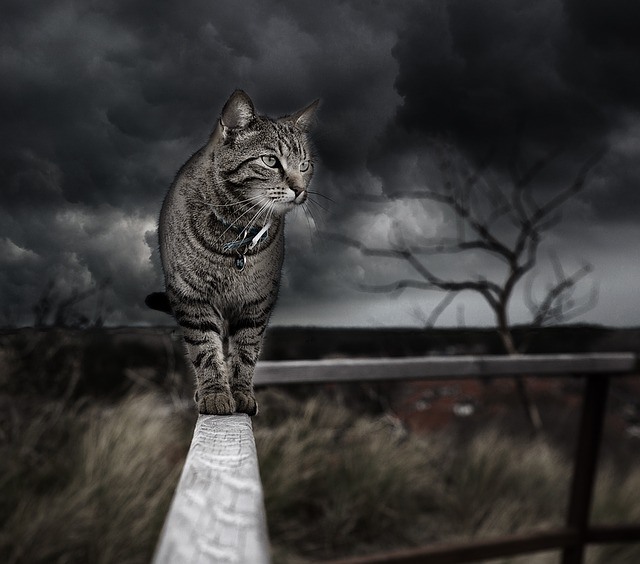by Crystal Caudill | Aug 23, 2017 | Writing Craft

Voice seems to be one of those elusive things I have encountered as an aspiring author. What is it? How do you know what your voice is? How do you know if it is unique? Until recently, I just avoided the whole issue because it seemed so convoluted.
But the day must come when we chase down that elusive concept in order to fully develop into who we are. So here it is, wrong or right, my own view and explanation of voice.
Author Voice:
An author’s voice is not one tangible element in a novel, it is the culmination of all the flavors an author brings to their writing. From genre choice, to settings, typical characters, humor, to even word choice – it all goes to develop a unique voice.
Take a look at this picture:

What story comes to your mind?
My first thought was a woman lying in bed, fumbling for a shoe to throw at the cat that never stops meowing out her window. Typical image? Yes, but give me time and I will develop it into a storyline that is unique. What if she killed the cat by accident? And what if it was her neighbor’s prize winner? Or even better, there was a note attached to it revealing a danger no one could have foreseen. Oh, so many ideas are skittering through my mind…
Maybe your first thought was a mystery, a ghost story, or something altogether different. Your author voice can change depending on your genre choice, and most of us tend to pick a particular genre and stick to it.
Three Examples:
 Mary Connealy has a voice I love. She has humor focused on the cowboy days of the west. Her females are almost always strong, independent women with quirky ways. Her characters are always unique and at odds with each other. Whenever I pick up one of her books I know there will be an element of danger, sweet romance, a splash of humor, a cowboy setting, and characters that make me smile.
Mary Connealy has a voice I love. She has humor focused on the cowboy days of the west. Her females are almost always strong, independent women with quirky ways. Her characters are always unique and at odds with each other. Whenever I pick up one of her books I know there will be an element of danger, sweet romance, a splash of humor, a cowboy setting, and characters that make me smile.

Jen Turano is another author with a unique voice. Whenever I pick up one of her books, I know they are going to take place in a city setting, with characters who are oddball in some way, danger will ensue, and hilarity prevails. When I need a good laugh, I turn to her or Karen Witemeyer.

My friend and critique partner, Joanna Davidson Politano, will be releasing her debut novel in October. While I won’t share details of her story now (you will have to wait until next month) Joanna has a voice that makes me swoon. Whenever I read her submissions, I know I will step into a Regency world clouded with mystery. Her books read like a mix of Bronte, Daphne Du Maurier, and Dickens. To read her work is to float through a world that entrances and intrigues, and I absolutely cannot wait for you to read her books!(Okay, swooning over.)
Bottom line, your voice is what a reader can expect to find when they pick up your book.
Finding Your Voice
Evaluate your writing. Do you notice certain trends? Are your stories dialogue heavy? Witty? Detail oriented? Do you add humor to your work? A little? A lot? Do you have odd ball characters? Do you choose a particular type of hero?
What settings do you tend to choose? Cities, the country, a particular region? Are they darker, brighter? Winter, Summer, Autumn, Spring? That can change with each book, but if you notice a particular trend, that just may be part of your voice.
Is your writing very formulaic or is it organic? Susie May Warren is very formulaic in her writing. She works in twenty chapter patterns and has a plan of what has to happen in each segment of her story. For others, there is no discernable pattern beyond the standard three-act plot.

By evaluating your writing, you can determine your strengths and weaknesses, elements that you want to refine and improve upon, maybe even elements you want to weed out of your writing altogether.
My voice is still developing, but I have decided that my voice includes a few elements: Danger and murder plots, women who are independent but get into lots of trouble, heroes who generally fall into the law enforcement category, clear villains, a splash of humor (although nowhere near the amount I thought I would have), and broken families. Forgiveness, redemption, and family are strong threads in what my stories encompass. Do I have a lot of work left? You betcha! Is my voice completely clear and finished? Nope, but I am working on it.
Now it is your turn to share. Comment below.
What do you want a reader to expect when they pick up your books? Have you discovered your own voice? Do you agree or disagree with my view of author voice? What would you add to this?
by Crystal Caudill | Mar 15, 2017 | Writing Craft
Characters are more than just the sum of their actions. In the previous weeks, I discussed character archetypes and negative/positive personality traits, but all of these really just boil down to actions. So what more do you need to create a living, breathing, well-rounded character?
 To give your characters the breath of life, you need to give them a past full of good and bad experiences, even though their full back story will never be revealed to the reader. Susie May Warren does a fantastic job of explaining how she does this in her book The Story Equation (SEQ), and I highly recommend getting it. For the meantime, here is the basic process derived from her SEQ.
To give your characters the breath of life, you need to give them a past full of good and bad experiences, even though their full back story will never be revealed to the reader. Susie May Warren does a fantastic job of explaining how she does this in her book The Story Equation (SEQ), and I highly recommend getting it. For the meantime, here is the basic process derived from her SEQ.
Developing Character History
Your character is who they are when they walk on the page due to their histories. As an author, it would be impossible create a comprehensive life story for your character from birth to the time they walk on the page. Many of those details are not important.
 The important details of our lives are those life-altering parts. Those moments in time that end up wounding you, burying a lie deep into your heart, and creating fears. Susie May Warren calls these Dark Moment Stories.
The important details of our lives are those life-altering parts. Those moments in time that end up wounding you, burying a lie deep into your heart, and creating fears. Susie May Warren calls these Dark Moment Stories.
Dark Moment Stories
These dark moment stories aren’t as vague as “my parents divorced.” As bad as divorce is, moments within the divorce will be what really shaped the experience of your character. They are the stories that can be retold in detail to another character.
For example, take a story of a four-year-old boy whose father walked out on him. That memory is so painful, so poignant it becomes immortalized in the mind, twisting and growing roots down to the soul.
He can remember his Dad loading up the car, ignoring the son as he followed behind asking questions.
“Daddy, where are you going?”
“Can I go, Daddy?”
“Why is Mommy crying?”
“Can I help?”
Then it happened. Dad closed the door, separating the boy from him forever. The boy runs to the window and watches as the car putters off into the distance without one backward glance from the driver.
Imagine the wound developed by that. What fears would develop from that experience? The fear of abandonment. The fear of being unworthy. The fear of being out of control.
Lies will develop from this experience. I’ll never be good enough. I am unlovable. I can’t trust people. People I love will always end up leaving.
These lies and fears developed from the wound determine the actions of our characters and make them believable. The wounding story is what makes us sympathize the character and even connect with the character. You don’t have to have your father abandon you to understand the feeling of abandonment.

Bringing your characters to life means giving them experiences that readers can connect to and identify with. Give them experiences that define who they are at the beginning, but are overcome and redefined at the end.
Exercise Your Brain
This week, come up with your own dark moment story for a character (or use a real experience, we’ll never know!). Then tell us the possible lies and fears developed from that dark moment story. Come back and encourage one another and comment on the different stories.
by Crystal Caudill | Mar 1, 2017 | Writing Craft

What draws you into a book? Is it the thrilling plot? The sizzling romance? The comical situations?
Or is it something more?
I am willing to bet that the reason you love your favorite book is not because of the plot but because of the characters that move through the plot.
As a writer, it is absolutely crucial to create characters that are well-rounded and real. So just exactly how is this done?
Creating Real People
 A couple weeks ago I discussed the idea of using archetypes to develop a general idea of your character’s profile. While the universal elements of archetype may draw a reader initially to a character, there must be something more than just kiddie pool depth for your characters to become favorites. They must be real.
A couple weeks ago I discussed the idea of using archetypes to develop a general idea of your character’s profile. While the universal elements of archetype may draw a reader initially to a character, there must be something more than just kiddie pool depth for your characters to become favorites. They must be real.
Real people have good qualities and bad qualities, or flaws as they are often referred to in the writing world. We see these traits in people through their actions. You don’t hear people going around announcing “I’m cynical” or “I’m adaptable” to the world (usually), and even if they did, you wouldn’t believe them until you saw it through their actions.
I can say I’m a morning person all I want, but until you see me actually  willingly getting my butt out of bed before 9 AM and happy about it, you might doubt it. By the way, if you haven’t guessed, mornings and I are not on speaking terms.
willingly getting my butt out of bed before 9 AM and happy about it, you might doubt it. By the way, if you haven’t guessed, mornings and I are not on speaking terms.
Thus, as a writer, it is critical to determine the personality traits of your characters, both good and bad, and determine ways to show this subtly through their actions.
Positive and Negative Traits
If you are like me, at the beginning, I struggled with deciding what are personality traits and the behaviors that go with my characters. Enter one of my favorite writing resources, Angela Ackerman’s and Becca Puglist’s Positive and Negative Trait Thesaurusus (or thesauri, depending on your grammar philosophy).
Each thesaurus includes a definition, category (they have a whole intro section on this), similar attributes, possible causes, associated behaviors, associated thoughts, associated emotions, positive aspects, negative aspects, examples in literature and film, traits in supporting characters that may cause conflict, challenging scenarios, and even how a negative trait can become overcome.
Whenever I create my hero, heroine, and even my “villain”, I am sure to pick out 3 – 4 positive and negative traits each to help define my character. Sometimes the traits are a major part of their character, and sometimes the traits are just one of those little quirks that people have.
Determining How a Character Behaves
After I have listed out their traits, I also list out the associated behaviors I can see my character doing. Sometimes I begin to see a pattern of behaviors that are repeated across traits and I realize these behaviors need to be something highly visual in my storyline. For quick reference sake, I “distill” my characters down to a few, easy to reference traits and behaviors to post onto my bulletin board.
Here is my heroine’s “distilled” list:
Values: Security, Loyalty, Honesty
- Holds on to goals long after prudent

- Unparalleled sense of morality
- fight for what is right no matter what
- Ferocious Loyalty
- Not letting others help
- Determined
- Refusing to admit defeat
- Acting without thinking of the consequences (courageous, impulsive)
- Spontaneous
- Acting in response to emotions (this and the next behavior cause inner conflict at times)
- Firm control of emotions
- Light manipulation to keep attention away from self
- Honest
- Thinks in metaphors
- Growing quiet, lost in thought
- Adventurous
- Creative problem solving
It might still need a little fine tuning, but I use it as a general list as I work through my story.
What about you? How do you determine what traits your character has? What traits do you admire in heroes or heroines?
You’ve learned part of my process above, but the traits I love most in my hero and heroines are quick wit, loyal, independent, and strong senses of justice. This is perhaps why most of the stories in my head center around some of those themes.
Come back in a couple weeks when I talk about Creating Well-Rounded Characters – Giving Them Life on 3/15/17.
Previous Post: Creating Well-Rounded Characters – Archetypes
by Crystal Caudill | Feb 15, 2017 | Writing Craft
Developing a well-rounded character takes time and purpose. I tend to be a panster (a writer who writes by the seat of their pants), but I have learned to develop my characters thoroughly before beginning to write.

Many authors do a character interview to help get to know their characters. I am slowly learning to do that using Susan May Warren’s SEQ technique (check out her book about it here), but I have also added my own twist to discovering the inner workings of my characters.
So what are those key components to take into consideration when developing a character?
In addition to SEQ, I like to explore my characters archetypes, positive personality traits, negative personality traits, and character backstory. Today I just want to focus on archetypes.
What are Archetypes?
Archetypes are just universal patterns of behavior that have positive and negative aspects.
Caroline Myss, “a pioneer in the field of energy medicine and consciousness”, suggests each person has a combination of about 12 archetypes that make up their psyche, each having varying degrees of presence in your life depending on your situation. I don’t get into all that “new age” feel stuff, but her collection of 72 Archetypes Cards are very useful in developing fictional characters.
Some examples of her archetypes are:
- Artist
- Child – Orphan
- Child – Wounded
- Detective
- Judge
- Knight
- Networker
- Prostitute
- Warrior
Developing Character Archetypes
For my characters, I choose between four and six archetypes that define who they are during my story. In fact, the list above is the archetypes I chose for my hero and heroine in my WIP.
Each archetype has positive and negative traits. Because the prostitute archetype might be a little concerning to you, I will share that one as my example.

“The Prostitute archetype engages lessons in the sale or negotiation of one’s integrity or spirit due to fears of physical survival or for financial gain. We prostitute ourselves when we sell our bodies or minds for money, or when we compromise our morals and ethics for financial gain… The core learning of the Prostitute is that self-esteem and self-respect make you impervious to selling out.”
– “Prostitute”, Caroline Myss Archetype Cards Booklet
Caroline Myss adds more, but as you can see from this description that “Prostitute” is not exactly what you first think. No, my heroine is NOT sexually immoral or active. What she does do is compromise her morals due to her fears of physical survival.
Have you ever compromised your morals due to self-preservation? It doesn’t have to be big and earth-shaking. It could be the one time you blamed your toddler sibling for eating all the cookies before dinner, even though you believe lying is wrong. See how the archetype can be used for everyday situations?
 Picking out four to six archetype cards really helps to round out your characters and make them multi-dimensional. The general strengths and weaknesses are outlined for you to expand upon and fine-tune for the uses of your own story. Characters can even have overlapping archetypes, yet be completely their own person, just like the human race in real life.
Picking out four to six archetype cards really helps to round out your characters and make them multi-dimensional. The general strengths and weaknesses are outlined for you to expand upon and fine-tune for the uses of your own story. Characters can even have overlapping archetypes, yet be completely their own person, just like the human race in real life.
Because archetypes are universal in nature, readers will connect to your characters because they see aspects of themselves within the story.
When developing your own characters, I highly recommend taking into consideration their archetypes. If you struggle with archetypes, I suggest picking up Caroline Myss’ Archetype Cards.
What other archetypes are you familiar with? Still confused? Leave a question below. I promise to get back to it as soon as I can.
Do you have any resources you use to help develop your own characters?
by Crystal Caudill | Jan 25, 2017 | Writing Craft

Sometimes as readers and writers, it is interesting and even helpful to hear from other published authors. Yesterday, you were able to read my review for Angela’s newest release, out this week, The Scarlet Coat. Today, Angela has graciously agreed to join my blog for an interview.
Once you have enjoyed the post, please join her Facebook Release Party. The actual party begins on Thursday, January 27th from 10 AM – 6 PM UTC-07 time (or 12PM to 8PM EST for those who were like me and went, huh?), but you can go ahead and check out a bit about the party and GIVEAWAYS!!! Wahoo!

Welcome, Angela! and thank you so much for agreeing to my quirky author interview. I’ve split my questions into two categories today: Questions about the Story and Questions about Writing.
Questions about The Scarlet Coat
How long have you wanted to write this story?
Not too long. I actually wrote this story as soon as I came up with the idea almost nine years ago! This is one of my first complete manuscripts. But it looked a lot different back then. The original was written in first-person and completely from the heroin’s point of view.
What do you love about The Scarlet Coat? Do you have a favorite scene?
I must say I love him. I loved writing the British officer who can’t remember who he is. I loved (once I added his point of view) letting him discover himself more honestly than he’d ever let himself before. My favorite scene is when his pride gets in the way of his good sense and he tries to leave before he’s able.
Were there any scenes you edited out of this book? Any of them you care to share? 
The whole last quarter of the book was completely rewritten when I went back to it a couple years ago. I don’t know what to say about the old end, though, without giving away too much of the new one. 😉
Which character did you identify with most?
Fine, I’ll admit it, Rachel and I share a lot in common. Maybe not in the first draft, but when I went back to this story, I decided I could give one of my heroine’s some of my personality. That’s when she started digging out the huge stump in the garden (I had one in my back yard, too.)

Your cover is beautiful. What was the cover design process like for you? Did you get to have any input?
Thank you! My publisher took care of all that. There were two little things they changed on my suggestion, but otherwise, they did a great job.
What is your biggest hope for your readers as they devour your book?
First, I do hope they devour it…or at least really enjoy it. But as they read, I do hope there moments where they contemplate their own relationship with God and consider His love for each of us.
Questions about Writing:
Do you believe in writer’s block?
I believe in needing to step back and do more research—whether that consists of real research into the era, or a long hot bath or walk to get the imagination flowing again. At least that’s what works for me.
Does writing energize or exhaust you?
Both. Sometimes the story is so exciting and it comes with such ease that energy flows through you. And other times it’s like pulling teeth and drains the life out of you. Thankfully the first is slightly more prevalent. 😉
What was the best money you ever spent as a writer?
Other than buying a laptop that wouldn’t die and dump chunks of a story, my ACFW membership was worth its weight in gold. The resources, contacts, and friends I have made are priceless. Every success I’ve had as a writer can be linked directly to American Christian Fiction Writers.
What did the road to publishing look like for you?
 I got my first nibble from a publisher back in 2009, just before I got engaged to my husband. They wanted to publish my book, (a different one) but when they ran the numbers they couldn’t fit it in the 2010 season. In 2011 they closed their doors. I got married and had a baby and didn’t do much writing for about 4 years. Then I felt strongly I needed to get back to work. Only now, I had a 2 year-old and a 9 month-old mama’s girl. I took an evening class in creative writing once a week for a semester and joined ACFW. That next summer I entered my first short story contest and was a finalist. The following (2015) summer, I entered two short story contests and won both! A couple months later I heard back from a small publisher offering me a contract for Her Blue-eyed Brave, (which will hopefully be released in the next year.) A month later I was given the contract for The Scarlet Coat and its sequel, The Patriot and the Loyalist. That has grown to a four book series that I am super excited about!
I got my first nibble from a publisher back in 2009, just before I got engaged to my husband. They wanted to publish my book, (a different one) but when they ran the numbers they couldn’t fit it in the 2010 season. In 2011 they closed their doors. I got married and had a baby and didn’t do much writing for about 4 years. Then I felt strongly I needed to get back to work. Only now, I had a 2 year-old and a 9 month-old mama’s girl. I took an evening class in creative writing once a week for a semester and joined ACFW. That next summer I entered my first short story contest and was a finalist. The following (2015) summer, I entered two short story contests and won both! A couple months later I heard back from a small publisher offering me a contract for Her Blue-eyed Brave, (which will hopefully be released in the next year.) A month later I was given the contract for The Scarlet Coat and its sequel, The Patriot and the Loyalist. That has grown to a four book series that I am super excited about!
How have you seen God through writing your novels?
There are moments when I look back on what I just wrote and realize I’m not that good. When the book and characters take me in a direction I’d never imagined or they say something that even gives me pause for thought…that’s when I know I’m not the only one moving my fingers across the keys.
My last but not least question, what advice would you give writer’s just beginning their journey?
Don’t do it alone! There are so many other writers out there who can help you on this journey, and who you can help. There is strength, knowledge, and resources in community. Plus a lot of commiseration and celebration during the highs and lows that come with this business.
Thank you again, Angela, for taking the time for this interview. Readers, don’t forget to join Angela’s Facebook Release Party! I hope to see you there! If you have any questions you want to ask Angela, post them below and I will pass them on and post her answer.
by Crystal Caudill | Jan 18, 2017 | Writing Craft
*This is an expanded edition of my guest blog post to Southern Writer’s Magazine on December 14, 2016.
Crafting the Perfect Chapter – It’s Elementary, My Dears

Before becoming a stay-at-home-mom, I taught fifth-grade students to analyze writing. I hadn’t given much thought to applying what I taught to my own writing until I substitute taught a fifth-grade reading class. That day, I discovered a crucial concept for every fiction writer.
Students all over the country are forced summarize every chapter they read by looking for these key things: Somebody… wants… but… so… then…
We, as writers, need to zero in on every chapter we write to make sure we can answer: Somebody… wants…. but…. so… then…
How do we do this? It’s elementary, my dears.

To illustrate this concept, I will use chapter eight of George Washington’s Socks. I will assume most my readers have not had the enjoyment of reading this children’s novel, so I will just give a very brief introduction to the story.
George Washington’s Socks
A mysterious rowboat transports five adventurous kids back in time to the eve of the Battle at Trenton where they experience the American Revolution. Through encounters with Hessian soldiers, revolutionaries, and even George Washington himself, Matthew, Quentin, Hooter, Tony, and Katie watch history unfold before their eyes as they see first-hand, the grim realities of war and the cost of freedom.
– Amazon.com Blurb
Somebody… wants… but… so… then…
Let’s break it down:

Somebody…
Who is the central focus of this chapter? This can be one or two characters if you are splitting your story between points of view, but even if there are multiple points of view, a chapter is generally about one person. Who would students identify as the main character for your chapter?
In George Washington’s Socks there are five focus characters, however, chapter eight focuses solely on the perspective of Matt.
Wants…
This is the goal of the main character for this chapter only. What is it that the character wants to accomplish in this small timeframe? More often than not it is a small goal that builds into something bigger.
For Matt, his initial goal in the chapter was to return General Washington’s cape.
But…
No story is engaging without conflict, and neither is a chapter. What obstacle does the character face? It can be internal or external in nature, but it needs to be plausible and, if at all possible, unforeseen.
Matt’s challenge comes in the form of a captain who believes Matt is a rebel soldier.

So…
This is the reaction to the conflict. What does the character do? What does he/she think? Do they change their goal? What about the supporting characters? How do they respond to the conflict, and how does their response affect the main character?
Matt changes his goal. He goes from wanting to return General Washington’s cape to retreating to the safety of the boat.

Then…
This is where a consequence occurs or an additional problem is added to the plot. There could be a hint to the subplot, or a difficult obstacle the character must face, or it could leave the reader with a cliffhanger. Whichever course you choose, the “then” is used as a hook for the next chapter.
Matt’s chapter doesn’t end with him being forced into battle. His “then” is the fatal injury of the only man who can get Matt home.
Combine all the elements and you get:
Matt wanted to return General Washington’s cape but a Captain thought he was a rebel soldier trying to desert, so Matt tries to return to the boat. Then, as Matt is being forced into battle, the only man who can get Matt and his friends home suffers a fatal injury.

Somebody… wants… but… so… then… is a quick, easy summary that drives to the heart of a chapter. Do each of your chapters contain these elements? Could you summarize them in this way?
Even scarier…. could a fifth-grader?
I challenge you to share one of your chapters in this way, and just so I am being fair, here’s my example from chapter one.
Kessara wants to pay off her grandfather’s debt, but she doesn’t want him to find out she had to save the family name again, so she goes to the cemetery at midnight to retrieve her secret stash of money. Then as she is returning to the carriage she stumbles upon a clandestine meeting between two criminals who spot her.
What do you think? How would you break down one of your chapters?


 Mary Connealy has a voice I love. She has humor focused on the cowboy days of the west. Her females are almost always strong, independent women with quirky ways. Her characters are always unique and at odds with each other. Whenever I pick up one of her books I know there will be an element of danger, sweet romance, a splash of humor, a cowboy setting, and characters that make me smile.
Mary Connealy has a voice I love. She has humor focused on the cowboy days of the west. Her females are almost always strong, independent women with quirky ways. Her characters are always unique and at odds with each other. Whenever I pick up one of her books I know there will be an element of danger, sweet romance, a splash of humor, a cowboy setting, and characters that make me smile.




 To give your characters the breath of life, you need to give them a past full of good and bad experiences, even though their full back story will never be revealed to the reader. Susie May Warren does a fantastic job of explaining how she does this in her book The Story Equation (SEQ), and I highly recommend getting it. For the meantime, here is the basic process derived from her SEQ.
To give your characters the breath of life, you need to give them a past full of good and bad experiences, even though their full back story will never be revealed to the reader. Susie May Warren does a fantastic job of explaining how she does this in her book The Story Equation (SEQ), and I highly recommend getting it. For the meantime, here is the basic process derived from her SEQ. The important details of our lives are those life-altering parts. Those moments in time that end up wounding you, burying a lie deep into your heart, and creating fears. Susie May Warren calls these Dark Moment Stories.
The important details of our lives are those life-altering parts. Those moments in time that end up wounding you, burying a lie deep into your heart, and creating fears. Susie May Warren calls these Dark Moment Stories.


 A couple weeks ago I discussed the idea of using
A couple weeks ago I discussed the idea of using  willingly getting my butt out of bed before 9 AM and happy about it, you might doubt it. By the way, if you haven’t guessed, mornings and I are not on speaking terms.
willingly getting my butt out of bed before 9 AM and happy about it, you might doubt it. By the way, if you haven’t guessed, mornings and I are not on speaking terms.



 Picking out four to six archetype cards really helps to round out your characters and make them multi-dimensional. The general strengths and weaknesses are outlined for you to expand upon and fine-tune for the uses of your own story. Characters can even have overlapping archetypes, yet be completely their own person, just like the human race in real life.
Picking out four to six archetype cards really helps to round out your characters and make them multi-dimensional. The general strengths and weaknesses are outlined for you to expand upon and fine-tune for the uses of your own story. Characters can even have overlapping archetypes, yet be completely their own person, just like the human race in real life.











